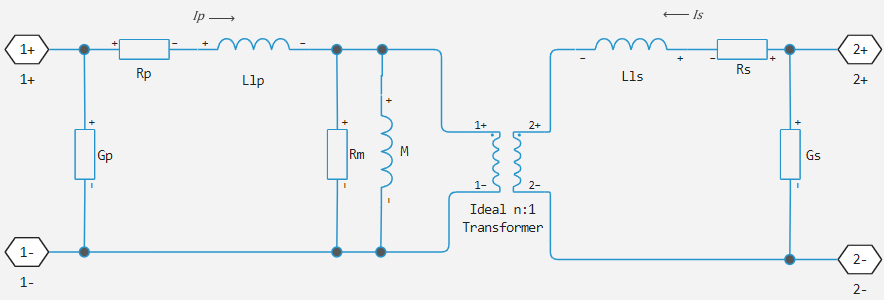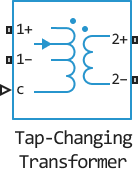Tap-Changing Transformer
Single-phase transformer with winding switching.
blockType: AcausalElectricPowerSystems.Passive.Transformers.TapChanging
|
Path in the library: |
Description
The Tap-Changing Transformer unit represents a single-phase tap-changing transformer. You can change the winding ratio of the transformer during the simulation using the control input.
Use this block to regulate or change the output voltage of a linear transformer during simulation. To simulate the saturation effect, use the block Nonlinear Transformer.
Operating principle
The signal at input port c is used to change the position of the transformer winding switch.
If the signal at the c port exceeds the positive value of the Control threshold parameter, t, the winding switch position p is increased by one.
If the signal at port c is below the negative value of Control threshold, t, the winding switch position p is decreased by one.
This figure shows the response of the winding switch to the control signal.

In the diagram:
-
- nominal number of winding turns of the winding switch winding.
-
- The percentage change in the number of turns per tap step. Set this value using the parameter Change per tap (%).
-
and the minimum and maximum permissible switching indices. Set these values with the parameters Minimum tap index (nominal=0) and Maximum tap index (nominal=0).
Use the Tap-changer location parameter to select the tap-changer winding. The overall transformer ratio depends on this parameter :
-
Primary winding
-
Secondary winding
where is the nominal transformation ratio.
Equivalent circuit
The equivalent circuit is shown in the figure.

Here:
-
RpandRsare the series resistances of the primary and secondary windings respectively. Changing the position of the winding switch affects these values. -
LlpandLlsare the scattering inductances of the primary and secondary windings respectively. Changing the position of the winding switch affects these values. -
RmandMare the magnetising resistance and inductance respectively. Changing the position of the winding switch affects these values. -
nis the transformation ratio. -
GpandGsare the primary and secondary winding scattering conductances respectively. Changing the winding switch position does not affect these values.
Ports
Non-directional
1+ - positive terminal of line 1
electricity
Electricity port, represents terminal 1 of the line with positive polarity.
1- is the negative terminal of line 1
electricity
Electricity port, represents terminal 1 of the line with negative polarity.
2+ represents the positive terminal of line 2
electricity
Electricity port, represents the terminal of line 2 with positive polarity.
2- is the negative terminal of line 2
electricity
Electricity port, represents line 2 terminal with negative polarity.
c - control signal
scalar
Input signal controlling the position of the winding switch.
Parameters
Main
*Turns ratio (primary/secondary)` - transformation ratio
`1 (by default)
Transformation ratio in the nominal position of the winding switch. The transformation ratio is defined as the number of turns of the primary winding divided by the number of turns of the secondary winding.
Primary leakage inductance - the primary leakage inductance.
0.0001 Gn (by default).
An inductance that represents the magnetic flux losses of the primary winding.
Secondary leakage inductance - secondary leakage inductance
`0.0001 Gn (by default).
An inductance that represents the magnetic flux losses of the secondary winding.
Magnetisation inductance - magnetization inductance
`100e-6 Gn (by default).
Magnetisation inductance for transformer.
Primary series resistance - primary series resistance
0.0 (By default)
Primary series resistance.
Secondary series resistance - secondary resistance
`0.0 (By default).
Secondary series resistance of the secondary winding.
Primary leakage conductance - primary winding leakage conductance
`0.0 (By default).
Primary leakage conductance. Set this value to non-zero to achieve numerical convergence in some circuit topologies.
Secondary leakage conductance - secondary leakage conductance
0.0 (By default).
Secondary leakage conductance. Set this value to non-zero to achieve numerical convergence in some circuit topologies.
Tap
Tap-changer location - tap-changer winding location
Primary (by default) | `Secondary `
Specify whether the tap-changer is located on the primary or secondary winding.
Minimum tap index (nominal=0) - minimum tap position of the winding switch
-5 (By default).
Minimum permissible tap switch position.
Maximum tap index (nominal=0) - maximum tap position of the winding switch
5 (by default).
Maximum permissible tap switch position.
Change per tap (%) - step of position change
`1% (By default)
The percentage change in the number of winding turns of the winding switch winding per position step. Set this value so that the absolute percentage change at the minimum and maximum position indices is less than 100%.
Control threshold - shift threshold
0.5 (by default).
The control value at which the winding switch position is changed. To decrease the winding switch position, apply a control signal smaller than this value. To increase the winding switch position, apply a control signal greater than this value.
